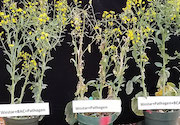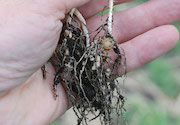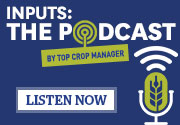| |
| |
 |
 |
| |
 |
|
@{mv_date_MMM d, yyyy}@ |
|
| |
 Cover crops can provide a variety of benefits. Seeding cover crops after a cereal crop harvest is one way to manage weeds, including glyphosate-resistant varieties like Canada fleabane and waterhemp.
» Read more...
Cover crops can provide a variety of benefits. Seeding cover crops after a cereal crop harvest is one way to manage weeds, including glyphosate-resistant varieties like Canada fleabane and waterhemp.
» Read more...
Lifelong agricultural ambassadors Jay Bradshaw, James Halford, Bryan Harvey and Douglas Hedley have been selected as the 2020 inductees into the Canadian Agricultural Hall of Fame.
» Read more...
The Canadian Agricultural Youth Council will advise Agriculture and Agri-Food Canada, including making suggestions on federal government priorities, identifying problems and proposing solutions on key issues.
» Read more...
|
| |
 |
 |
| |
|
| |

Cover crops are becoming one of the best ways to help you manage weed resistance sustainably across the board. But how do you know which cover crop is best for your fields? What factors do you need to consider? Check out our webinar series “How to choose a cover crop” at mixitup.ca. You’ll learn about the factors you need to think about when choosing a cover crop to get ahead of weed resistance.
>> Visit mixitup.ca to get started now! |
| |
|
| |
 Sclerotinia stem rot, caused by the pathogen Sclerotinia sclerotiorum, is one of the most destructive diseases of canola. The pathogen causes disease on more than 400 plants, according to Susan Boyetchko, an AAFC Saskatoon research scientist. She’s part of a Prairies research team examining selected bacterial strains as biopesticides and their ability to control Sclerotinia development.
» Learn more
Sclerotinia stem rot, caused by the pathogen Sclerotinia sclerotiorum, is one of the most destructive diseases of canola. The pathogen causes disease on more than 400 plants, according to Susan Boyetchko, an AAFC Saskatoon research scientist. She’s part of a Prairies research team examining selected bacterial strains as biopesticides and their ability to control Sclerotinia development.
» Learn more |
| |
 The Gray Luvisolic soils of northern Alberta, Saskatchewan and Manitoba are naturally low in soil organic matter (SOM); the process of readying the soil for cultivation reduces SOM even further. Soil acidity, low fertility and susceptibility to wind erosion create additional difficulties. However, long-term research has shown that general management practices can be very helpful to improve soil quality and crop productivity.
» Learn more
The Gray Luvisolic soils of northern Alberta, Saskatchewan and Manitoba are naturally low in soil organic matter (SOM); the process of readying the soil for cultivation reduces SOM even further. Soil acidity, low fertility and susceptibility to wind erosion create additional difficulties. However, long-term research has shown that general management practices can be very helpful to improve soil quality and crop productivity.
» Learn more |
| |
|
| |
 Field scouting should happen regularly through the season, and while digital platforms can’t replace boots on the ground, they can be helpful supplementary tools in the scouting toolbox. In this episode of Inputs, the podcast by Top Crop Manager, Lydia Parker, field product specialist with Climate FieldView, shares some of the ways a digital scouting platform can help you through your growing season.
» Listen Now
Field scouting should happen regularly through the season, and while digital platforms can’t replace boots on the ground, they can be helpful supplementary tools in the scouting toolbox. In this episode of Inputs, the podcast by Top Crop Manager, Lydia Parker, field product specialist with Climate FieldView, shares some of the ways a digital scouting platform can help you through your growing season.
» Listen Now |
|
 This episode of Inputs is all about insects. Tracey Baute, field crop entomologist with the Ontario Ministry of Agriculture, Food and Rural Affairs (OMAFRA), and Tyler Wist, field crop entomologist with Agriculture and Agri-Food Canada (AAFC) in Saskatoon, shed light on the environmental conditions that create insect pressure, which insects to watch for in August, and useful resources that will help identify and manage insect pests.
» listen Now
This episode of Inputs is all about insects. Tracey Baute, field crop entomologist with the Ontario Ministry of Agriculture, Food and Rural Affairs (OMAFRA), and Tyler Wist, field crop entomologist with Agriculture and Agri-Food Canada (AAFC) in Saskatoon, shed light on the environmental conditions that create insect pressure, which insects to watch for in August, and useful resources that will help identify and manage insect pests.
» listen Now |
| |
|
| |
The research aims to support farmers in adopting best soil health and water protection practices.
» Read more
Under the pilot project, FCC provided $50,000 in funding to facilitate mental health first aid training for producers and the agriculture industry.
» Read more
In a survey of farm employers, more than 47 per cent continually face challenges related to securing enough workers.
» Read more
|
| |
| |









